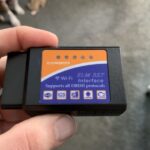The Continuous Obdii Monitor, a critical component of your vehicle’s onboard diagnostic system, constantly assesses various systems to ensure efficient operation and minimize emissions. This article delves into the functionality of several key continuous monitors, outlining their roles in maintaining vehicle health.
The Crucial Role of the Oxygen Sensor Heater in Continuous OBDII Monitoring
The oxygen sensor heater monitor, essential for spark ignition vehicles, verifies the functionality of the oxygen sensor’s heating element. This heater enables the oxygen sensor to reach its operational temperature (around 600°F) rapidly, allowing the vehicle to transition from open-loop to closed-loop mode. In open-loop, the engine operates without feedback from the oxygen sensor, leading to lower efficiency and higher emissions. Closed-loop operation, reliant on a heated oxygen sensor, allows the engine control unit (ECU) to adjust the air/fuel mixture for optimal performance and reduced emissions. This continuous obdii monitor is a two-trip monitor, meaning the malfunction indicator lamp (MIL) illuminates only after two consecutive trips with a detected fault.
Oxygen Sensor Monitor: The Key to Precise Air/Fuel Ratios
Working in tandem with the oxygen sensor heater, the oxygen sensor monitor assesses the oxygen content in the exhaust stream. It generates a voltage signal corresponding to the oxygen level, which the ECU uses to fine-tune the air/fuel mixture. A high voltage signifies a rich mixture (too much fuel), while a low voltage indicates a lean mixture (too much air). This continuous obdii monitor, also a two-trip monitor for spark ignition vehicles, ensures optimal combustion and minimal emissions. A properly functioning oxygen sensor is crucial for achieving the ideal air-fuel ratio of 14.7:1.
Secondary Air System Monitor: Enhancing Catalytic Converter Efficiency
The secondary air system monitor, active during engine warm-up, ensures the proper functioning of the secondary air injection system. This system introduces air into the exhaust stream to facilitate the catalytic converter’s operation, oxidizing harmful pollutants like carbon monoxide and hydrocarbons. This injection also helps the catalytic converter reach its operating temperature faster. This continuous obdii monitor is a two-trip monitor and runs once per trip.
Beyond Oxygen: Other Continuous OBDII Monitors in Compression Ignition Vehicles
Compression ignition vehicles employ several other continuous obdii monitors, including:
-
Non-Methane Hydrocarbon Catalyst (NMHC) Monitor: Evaluates the efficiency of the NMHC catalyst, responsible for converting harmful non-methane hydrocarbons into less harmful substances. This monitor also ensures adequate temperature for particulate matter filter regeneration.
-
NOx Aftertreatment Monitor: Supervises the NOx aftertreatment system, which reduces nitrogen oxides in the exhaust. This system typically utilizes a specialized catalytic converter with a zeolite coating to trap and neutralize NOx molecules.
-
Boost Pressure System Monitor: Checks the integrity and operation of the boost pressure system, which increases intake manifold pressure for enhanced combustion efficiency.
-
Exhaust Gas Sensor Monitor: Monitors the exhaust gas sensor to identify issues that might affect other emission control systems. This provides comprehensive oversight of exhaust gas composition.
-
PM Filter Monitor: Assesses the performance of the particulate matter (PM) filter, which traps soot particles from the exhaust. This monitor tracks both the filter’s trapping efficiency and its self-cleaning (regeneration) capability.
Conclusion: Continuous OBDII Monitoring for a Healthier Vehicle
Continuous OBDII monitors play an indispensable role in maintaining vehicle performance, fuel efficiency, and minimizing emissions. By understanding their functions, drivers can better appreciate the complexity of modern engine management systems and the importance of addressing any indicated faults promptly. These continuous diagnostics ensure a cleaner, more efficient driving experience.

